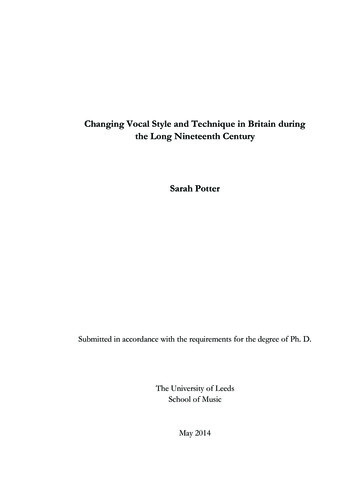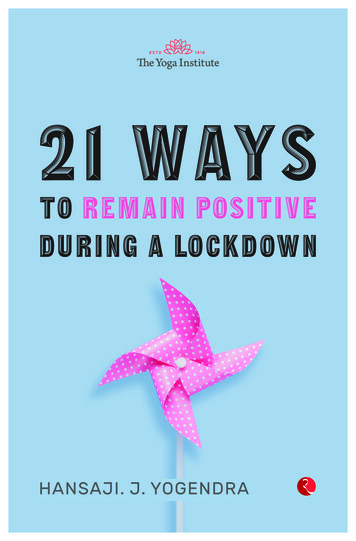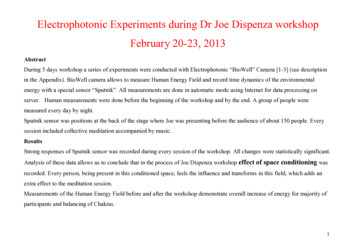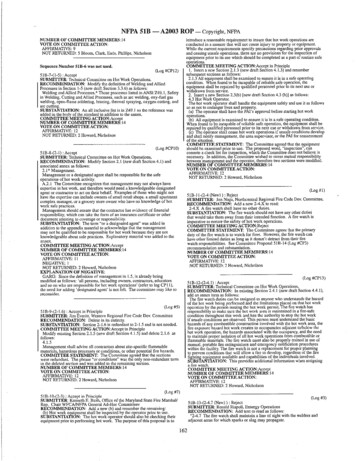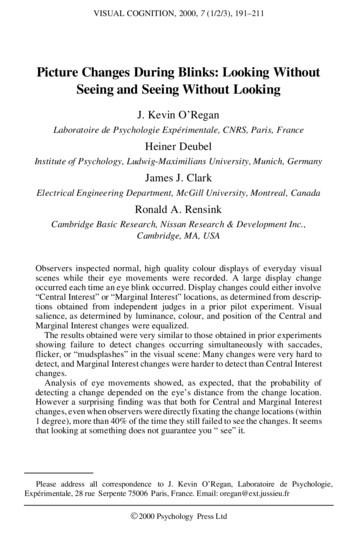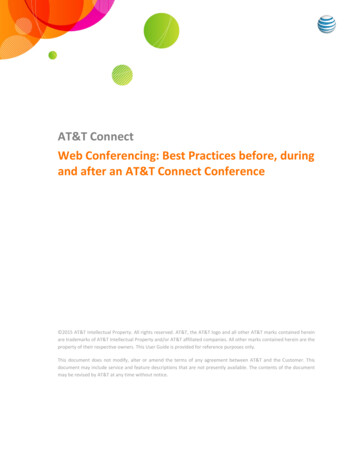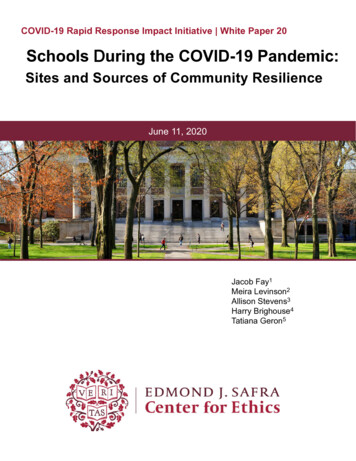
Transcription
COVID-19 Rapid Response Impact Initiative White Paper 20Schools During the COVID-19 Pandemic:Sites and Sources of Community ResilienceJune 11, 2020Jacob Fay1Meira Levinson2Allison Stevens3Harry Brighouse4Tatiana Geron5
AbstractAlong with the economy and health care system, schools are an essential third pillar in promoting community resilience and rebuilding communities’ physical, economic, emotional, social, and cultural healthin the wake of the global COVID-19 pandemic. Schools serve as sites and sources of community resilience in five distinct ways: they distribute social welfare services, promote human development, carefor children, provide stable employment, and strengthen democratic solidarity. Yet long-term physicalschool closures—along with impending budget cuts driven by cratering state and local economies andtax revenues—make it extremely difficult for schools to perform any of these roles. We recommendthree steps for restoring schools’ capacities to support community resilience. First, state and districtleaders should set metrics for achieving access and equity in each of the five roles that schools play,not just in academic achievement. Second, to establish these metrics, policymakers should developor strengthen mechanisms to engage diverse community voices, as local community members oftenbest understand the specific ways in which their own schools support or impede community resilience.Finally, Congress should allocate significant increases in federal funding to support public schools anddistricts for at least the next two years; these allocations should include strong supports for highneeds districts in particular.To read more about educational ethics in a pandemic, see white paper 17, "Educational Ethics During a Pandemic," by Meira hics-pandemic.1 Postdoctoral Fellow, Edmond J. Safra Center for Ethics, Harvard University2 Professor of Education, Harvard Graduate School of Education3 Ph.D. student, Harvard Graduate School of Education4 Mildred Fish Harnack Professor of Philosophy and Carol Dickson Bascom ProfessorUniversity of Wisconsin--Madison5of the Humanities,Ph.D. student, Harvard Graduate School of EducationThe authors are grateful to Susanna Loeb for helpful conversation and to Marty West for incisive feedback.Edmond J. Safra Center for Ethics COVID-19 White Paper 202
Table of Contents0102030405060708IntroductionSocial WelfareHuman DevelopmentChild CareEmploymentDemocratic Edmond J. Safra Center for Ethics COVID-19 White Paper 20
01Schools during the COVID-19 Pandemic: Sites and Sources of CommunityIntroductionPublic schools6 are important institutions in virtually every community in the United States, from ourmost sparsely populated rural counties to our largest cities. They are places where childrencollectively grow up. They are key partners to families, providing predictable, reliable child care at aneconomy of scale and supporting children’s development. They provide food and health services tochildren with limited access to each. They are sources of stable, middle-class employment for manyadults. They are also sites of disaster relief, citizenship education, voting, town meetings, andcelebratory moments of pomp and circumstance.As we move forward to construct our “new normal” in the wake of the COVID-19 pandemic, we musttherefore recognize that along with the economy and health care system, schools are an essential thirdpillar in promoting community resilience and rebuilding communities’ physical, economic, emotional,social, and cultural health. Supporting schools amid the pandemic is thus about much more than reconfiguring learning opportunities, as crucial as that is. In fact, focusing solely on schools’ capacities toprovide high-quality remote learning opportunities to students at scale may perversely weaken communities by failing to recognize schools’ diverse and far-reaching roles in promoting community resiliencethrough non-teaching roles such as child care, social welfare services, and stable adult employment.Pandemic-resilient schools can (and are essential to) contribute to a pandemic-resilient society (Allenet al., 2020) when they are capable of fulfilling each of the five essential roles they have historicallyplayed in promoting pre-pandemic community resilience: social welfare services, human development,child care, employment, and democratic solidarity.Yet the long-term closures that the pandemic requires have made it difficult, if not impossible, forBy public schools, we mean traditional public schools, public charter schools, Department of Defenseschools, and tribal -covid-19Edmond J. Safra Center for Ethics COVID-19 White Paper 204
Schools during the COVID-19 Pandemic: Sites and Sources of CommunityIntroductionschools to perform any of these roles. The shift to remote education has laid bare deep educational inequities, as many students are not able even to access online schools or much-needed resources. Withbrick-and-mortar schools closed, parents across the country struggle to balance child care, educationalinstruction, and their jobs. And schools’ role as employers—in many communities the single-largest local employer capable of providing middle-class or living wages—is facing the threat of severe budgetcuts that may force them to lay off or furlough substantial portions of their workforces (Litvinov, 2020;Strauss, 2020). Even when schools have been able to sustain one of these crucial roles—namely,their ability to continue food distribution to students and families—cracks have become evident. Manyeligible families have been unable to pick up food because of essential work schedules or lack of transportation (DeParle, 2020), and increasing numbers of Americans who are food insecure for the first timebecause of the pandemic-induced shutdown are reaching out to schools for support (Bauer, 2020). It isunclear whether schools have the resources to meet this growing need.As the pandemic continues to shake the foundations of the country’s economy and social fabric, schoolsneed support along each of the five dimensions of community resilience so that they, in turn, can support the families and communities who rely on them in so many different and vital ways. In what follows,we detail each of these sources of resilience and the impact of the pandemic on schools’ ability to realize them. We then offer a series of recommendations for policymakers that would enable schools tosustain communities during this moment of global ovid-19Edmond J. Safra Center for Ethics COVID-19 White Paper 205
02Schools during the COVID-19 Pandemic: Sites and Sources of CommunitySocial WelfareDespite U.S. education reformers’ single-minded focus over the past thirty years on assessing schools’academic outcomes above all else, schools have always provided vital physical, mental, and emotional social welfare services to children and families. These important services enable the academicachievement by which schools are most often evaluated. They also frequently underpin the physicaland economic health of communities made vulnerable by inadequate insurance, family instability, environmental toxicity, and jobs that fail to pay a living wage.In 2016/17 (the most recent year for which complete data is available), for instance, public schoolsprovided free or reduced-price meals to over 26 million students, or 52% of all school children (NCES,2019a). Estimates for 2019 show that U.S. public schools served 3.6 billion free and reduced-pricelunches; they also served over 140 million meals in the summer (USDA, 2020). Furthermore, manycommunity partners, districts, schools, and individual educators supplement these federally fundedprograms to improve children’s nutrition. After-school partners provide snacks and often dinner to hungry students; many schools send home backpacks on Friday afternoons with food to tide families overfor the weekend; and countless teachers keep granola bars, apples, and other grab-and-go snacks instock for students who need them.K-12 schools also provide physical and mental health services to millions of students per year, including vaccinations; management for chronic diseases such as diabetes, asthma, or ADHD; sexual andreproductive health education and services; vision, dental, and mental health screenings and services;nutrition health education; and hypertension screening (Baltag et al., 2015). School nurses and counselors are particularly powerful providers of care (Maughan, 2018); recent studies have found thatabout three-quarters of students who receive any mental health services get them in their schools, forinstance, and that students are “21 times more likely to visit school-based health centers for vid-19Edmond J. Safra Center for Ethics COVID-19 White Paper 206
Schools during the COVID-19 Pandemic: Sites and Sources of CommunitySocial Welfarehealth services get them in their schools, for instance, and that students are “21 times more likely tovisit school-based health centers for mental health than community mental health centers” (Whitaker etal., [2019]). Although the nationwide shortage of nurses has made it hard for schools, like communityhealth centers and hospitals, to maintain adequate staffing levels (Washburn, 2019), U.S. schools stillemploy approximately 95,800 FTE nurses to serve a population of about 55 million students (Willgerodt,2018). Vital health services are also provided by 111,000 school counselors, 32,000 social workers, and41,000 school psychologists (as of 2012; see NCES, 2012). Often these providers are the first point ofcare, especially in under-resourced areas (Whitaker et al., [2019]); about a quarter of students servedby a dental outreach program in Michigan, for example, had never seen a dentist before (Albanese,2014), and over 6,500 students in Baltimore Public Schools have received glasses since 2016 thanksto school-based screenings (Hub Staff, 2019). Unfortunately, availability does not fully match need.The most vulnerable students often attend schools in districts with the worst ratio of counselors andnurses to students (Willgerodt et al., 2018; Gagnon & Mattingly, 2016; CLASP, 2015). This is one ofthe reasons teachers went on strike in Los Angeles Unified and Oakland, California, in 2018 and 2019;the unions made increased nursing capacity a key demand (Washburn, 2019) and won concessions inboth cases.Schools also act as hubs for a wide range of therapeutic and social services. In 2015, for instance,nearly 60,000 students received occupational therapy in the New York, Chicago, and Los Angeles public schools alone (Harris, 2015); schools also provide regular speech and physical therapy to children.Every day, educators identify and advocate for students who need evaluation or support by social services agencies. Students who are homeless, in foster care, or are experiencing significant life changesare often supported by school programs that support their well-being and stability (Belsha, 2020). Manyschools also provide before- and after-school wrap-around services, including everything from musiclessons to behavioral therapy, to offer flexibility for parents and enrichment for the students who ovid-19Edmond J. Safra Center for Ethics COVID-19 White Paper 207
Schools during the COVID-19 Pandemic: Sites and Sources of CommunitySocial WelfareThe estimated 5,000 community schools in the United States go even further, providing health care,English as a Second Language classes, parenting classes, and housing and job supports to children’sfamilies and others throughout the community (Dryfoos et al., 2005; NCCS, 2020; Trujillo et al., 2014).During the COVID 19 pandemic, schools’ role as social welfare providers has been challenged by physical school closures. Students no longer have in-person access to the early intervention services, socialworkers, counselors, nurses, and numerous other resources that schools provide. Although specialeducators and occupational and speech therapists are trying to connect virtually with students (Mitchell,2020), many students are losing valuable ground without in-person services and supports, and othersawaiting services may not receive the diagnosis they need until schools reopen (Mader, 2020; Preston,2020). Calls to child abuse hotlines have dwindled during COVID-19; experts believe that this drop inreporting is due to school closures rather than actual reductions, since school workers are distancedfrom their students and are less well-situated to detect abuse (Schmidt & Natanson, 2020; Stewart,2020). Schools and districts have made herculean efforts to organize food distribution to children—andoften to hungry adults as well, no questions asked (Levinson, 2020; Malkus & Christensen, 2020c).Los Angeles Unified School District, for example, has provided almost 5 million meals to adults andstudents while also providing nutritional assistance to thirteen temporary homeless shelters (Nittle,2020). But meal access is still radically below normal levels, at a time when food insecurity is massivelyincreasing due to cascading job losses. Only 15% of eligible children (4.4 million out of 30 million total)have received Pandemic-EBT electronic grocery cards set up by Congress’s Families First Act—inmany cases because states have to coordinate with individual school districts to get eligible students’names and addresses (DeParle, 2020), as they are the onl only governmental agencies that keep trackof school children suffering hunger. The Census Bureau (Callen, 2020) and Brookings (Bauer, 2020)have similarly found that since pandemic-related shutdowns, nearly one-fifth to one-third of all familieswith children report food insecurity, and researchers Elizabeth Ananat and Anna Gassman-Pines d-19Edmond J. Safra Center for Ethics COVID-19 White Paper 208
Schools during the COVID-19 Pandemic: Sites and Sources of CommunitySocial Welfarefound that only 11 to 36% of low-income students in Philadelphia are even able to pick up grab-and-gomeals provided by the school district (DeParle, 2020). Closing school’s physical locations, while crucialfor public health reasons, has substantially weakened community resilience by preventing students andfamilies from accessing vital social welfare -covid-19Edmond J. Safra Center for Ethics COVID-19 White Paper 209
03Schools during the COVID-19 Pandemic: Sites and Sources of CommunityHuman DevelopmentModern societies rely on two central institutions to work in tandem to support children’s educationaldevelopment—the school system and the family. This partnership supports community resilience in twodifferent ways. First, schools are vital partners in the shared work of child development. While children’shome environments have significant impact on their school-based learning (Coleman, 1966; Osher etal., 2020; Reardon, 2011), schools are primary sites of formal academic, social-emotional, civic, andvocational learning for the vast majority of children in the U.S. As many parents have been dismayed todiscover while trying to homeschool during the pandemic, teaching algebra, reading, coding, or musicrequires specialized knowledge and skills, which professional teachers have and parents generally lack.By bringing numerous children and adults together into one shared space, schools also provide youngpeople opportunities to develop friendships and other meaningful relationships, to develop emotionalregulation and executive function skills beyond the family setting, to develop civic knowledge and habitsof civic engagement, and to gain valuable workplace skills including group work skills and vocationspecific skills such as nursing or car repair. Schools can also harness economies of scale unavailableto families because a single teacher can educate multiple children at a similar stage of developmentat a time. Furthermore, schools can improve the prospects of students whom our society systematically disadvantages in other ways. U.S. schools are characterized by deep disparities in achievementand opportunity, by race and class in particular, but there is also good reason to believe that withoutschools, these disparities would be even larger (Reardon, 2011; Center on Education Policy, 2007).Second, schools support long-term community resilience by providing individuals with the knowledgeand skills necessary for sustaining collective community life. In addition to the effects of education forindividuals, we all collectively benefit from higher levels of educational goods in the population. Highlevels of education enable greater economic productivity, quicker and better solutions to social andeconomic problems, and greater and more complex cultural production, not to mention healthier -19Edmond J. Safra Center for Ethics COVID-19 White Paper 2010
Schools during the COVID-19 Pandemic: Sites and Sources of CommunityHuman Developmentlonger lives (Sen, 2009; Mcgregor, 1994; Moretti, 2004a, 2004b). Never is this clearer than in a majorpublic health crisis in which we rely not just on the dedication and commitment of health professionals,but also on their knowledge and skills.Yet, the pandemic has disrupted the traditional division of labor between families and schools, affectingboth the short- and long-term ways that human development supports community resilience. Schoolstypically promote human development through embodied, synchronous interaction: teachers and students are in the same room at the same time, and whatever work they do outside that room, alone orwith others, is organized around that embodied interaction. That is exactly what schools cannot do during a pandemic: public health precautions require teachers and students to be physically isolated fromone another.Schools have thus shifted to using alternative modes of delivery. In fact, in just eleven days during thepandemic, the percentage of schools providing remote learning increased from 43 to 71% (Malkus &Christensen, 2020b), and by late April virtually all schools and districts had remote learning plans inplace (Malkus & Christensen, 2020c). Despite classroom closures, teachers in 60% of schools havebeen encouraged to connect with their students through synchronized video lessons, independentlearning platforms, or email (Malkus & Christensen, 2020a). But without training, practice, preparation,or a proven infrastructure, these efforts have proven to be substantially less effective at driving learningthan traditional in-person modes of instruction (Goldstein, 2020; Reich et al, 2020). Furthermore, theevidence suggests that the “online penalty” (Dynarski, 2018) has proven even harsher for already-vulnerable students, in particular low-income students, students with disabilities, and students in historically marginalized schools and communities (Goldstein, vid-19Edmond J. Safra Center for Ethics COVID-19 White Paper 2011
Schools during the COVID-19 Pandemic: Sites and Sources of CommunityHuman DevelopmentMost parents are ill-equipped to step fully into teachers’ educational roles even under propitious circumstances. Teaching is already a complex task that requires professional judgment and expertise thatmost parents lack (Alterator et al., 2018; Parker & Hess, 2001; Shulman, 1986). On top of that, mostparents are either trying to balance an increased role in educating their children with the other job theywere already doing, or are trying to educate their children while they endure the stresses associatedwith the loss of the job they were previously doing (Long, 2020; Harris, 2020). The vast majority of parents cannot simply step into the role of teacher and do so effectively.Public health concerns justify the closure of schools in most places right now, despite the costs to individual and collective human development. But there is every reason to suspect that those costs will besubstantial (Dorn et al., 2020). This will be especially true for students whose families are particularlystressed by the virus, whether because they are in populations that are disadvantaged due to U.S.socioeconomic and racial structures, or because their parents work in positions that are vulnerableto infection, or because they are sick, or because they have special educational needs (Kelly & King,2020; Kufeld & Tarasawa, vid-19Edmond J. Safra Center for Ethics COVID-19 White Paper 2012
04Schools during the COVID-19 Pandemic: Sites and Sources of CommunityChild CareThe impact of the sudden, sustained disruption of the family-school division of labor extends beyond human development concerns. Perhaps the single most (formerly) underappreciated way in which schoolssupport community resilience is in their role as sources of stable, safe child care. According to the Bureau of Labor Statistics, in 2019 roughly 40% of all U.S. families had children under the age of eighteen(US BLS, 2020). Although children spend only one-third of their waking hours, or about 1,000 to 1,200hours a year, in school (Craw, 2020; Wherry, 2004), the COVID-19 pandemic has revealed two distinctways in which the time schools do care for children is absolutely vital. First, school closures have causedreal stress and hardship to both unemployed and working parents. Second, while schools remain closedand parents lack dependable child care, there is no clear path toward full economic recovery.Parents struggle as a result of school closure in different ways given the varying impact of the pandemicon their ability to work. Far too many parents have lost their jobs as a result of the pandemic. In additionto providing care for their children, they may be searching for work, navigating overwhelmed unemployment offices, or fighting with landlords about rent (McCarthy et al., 2020). Most parents of school-agechildren who have not lost jobs continue to work. Yet now they must do so while they balance childrearing full-time—a challenge that has led to reported declines in family well-being within a week following astay-at-home requirement (Ananat & Gassman-Pines, 2020). Through social media and widely sharedopinion columns, parents offer glimpses into their reality. Two-parent families struggle to adapt to various coping strategies, including alternating work hours or working early or late in the day if their joballows (Manjoo, 2020), while single-parent families face even steeper obstacles (Bobrow, 2020). Someschools have attempted to ameliorate parents’ child care obligations through providing synchronousclasses or assigning projects and other school work designed to occupy students for long stretches oftime. While this has proved a boon for some families, it has imposed additional burdens on others whosechildren need extra support to access the technology or complete the work. Particularly for covid-19Edmond J. Safra Center for Ethics COVID-19 White Paper 2013
Schools during the COVID-19 Pandemic: Sites and Sources of CommunityChild Carewith young children, children with special needs, or multiple siblings, managing school work adds to thechild care burden rather than relieving it (Cavanagh & Fox, 2020; Parcak, 2020).Other parents—many in what are considered to be essential services—have to leave the home for workand thus require child care. Unless they have some other support—a non-working spouse, a grandparent, an older child—such workers are torn between their job and taking care of their children. Findingchild care elsewhere is no easy task—child care is expensive and in short supply (Lukas, 2020). Makingmatters worse, some companies that remained open or have recently reopened have told employeeswho are unready or unable to return to work that they will lose their jobs—and possibly their unemployment benefits as well (Carlisle, 2020; Alabama Department of Labor, 2020).While parents may feel these challenges individually, the loss of schools as a source of child care hasan additional collective impact that may even magnify parents’ individual struggles: the pace at whichthe economy is able to recover (Newkirk & Baker, 2020). As a result of the COVID-19 pandemic, theU.S. GDP contracted by nearly 5% in the first quarter of 2020. This economic crunch has been painful for the vast majority of American families (Council of Economic Advisers, 2020). However, whilereopening the economy occupies nearly everyone’s attention, the intermediate step of providing childcare for parents so that they are even able to work, either in the home or outside it, is all too quicklyglossed over.Schools’ role in providing stable, dependable child care is thus a vital source of community resilience:without it families suffer and economic productivity falters. As a Massachusetts state senator put it,policymakers should understand child care as “part of our infrastructure as important as roads andbridges and public transportation” (Ebbert & Moore, 2020). This sentiment quite rightly prioritizes thelabor that enables large-scale economic productivity, but it also should remind us that child care is already part of every state’s infrastructure through their public covid-19Edmond J. Safra Center for Ethics COVID-19 White Paper 2014
05Schools during the COVID-19 Pandemic: Sites and Sources of CommunityEmploymentIn addition to enabling adults to work by providing child care, public schools further strengthen theeconomic life of a community because they themselves are sources of employment. There are roughly8.6 million people employed in U.S. public and private schools (US BLS, 2019), including 3.2 millionpublic school teachers and almost 500,000 private school teachers (NCES, 2019b). Millions more arecustodians, bus drivers, cafeteria staff, and teacher aides. For rural communities, schools are oftenthe single largest employer. In North Carolina, for example, schools are the largest employer in 59 ofthe state’s 100 counties (Public Schools First, 2020). For communities of color such as New Orleans,teachers have often made up the bulk of the Black middle class (Buras, 2011). Yet there is surprisinglylittle empirical research that examines how schools’ role as sources of employment contributes to stronger communities.One reason for the dearth of research is that questions about schools as employers may be, under nonpandemic conditions, relatively uninteresting. Teaching has a long reputation as a solid, middle-classprofession. But that reputation was under scrutiny before the pandemic. A series of recent high-profilestrikes in states like West Virginia, Kentucky, Oklahoma, North Carolina, Arizona, Colorado, and California called attention to the growing impossibility of raising a family on a teacher’s salary (Van Dam,2019). Indeed, a Pew Center report indicates that as many as one in six U.S. teachers hold a second jobduring the school year (Schaeffer, 2019). Such economic realities have left some wondering if teachingwill remain a stable source of middle-class employment (Kim, 2018). Districts also have a long historyof preferential hiring for White teachers and administrators and disproportionate firing of educators ofcolor, particularly during economic contractions or other systemic shocks (Carver-Thomas, 2017).The COVID-19 pandemic may hasten such concerns.7 With state tax revenues cratering as a result ofNote that we are not arguing that jobs should be kept artificially high in the face of future technological or other potentialefficiencies. Rather, districts should not shed jobs during this time of crisis since pandemic-driven job losses could be economically devastating to communities around the country, and the workers perform essential ng-covid-19Edmond J. Safra Center for Ethics COVID-19 White Paper 2015
Schools during the COVID-19 Pandemic: Sites and Sources of CommunityEmploymentboth spikes in unemployment and decreased consumer spending, states project deep budget shortfalls, which in the absence of additional federal investment will force across-the-board spending cuts(Strauss, 2020). Schools are likely to face steeper spending cuts than during the Great Recession,which saw 120,000 teachers lose their jobs. A 15% reduction in school budgets as a result of the pandemic could result in an estimated loss of upwards of 300,000 teaching jobs (Griffith, 2020). Otherprojections are even more grim; the Council of Great City Schools estimates that 275,000 teacherscould lose their jobs just in big city districts (Ujifusa, 2020), and the National Education Association hasprojected 1.89 million job losses in the absence of supplemental federal funding (Litvinov, 2020). Making matters worse, schools need to expend even more resources to achieve social distancing: coveringincreased expenditures like expanding the number of bus routes, installing air quality systems, makingsure students have technology for remote education, or simply sanitizing surfaces throughout the day.The combination of reduced budgets and increased expenditures has led some superintendents towonder if it is even financially feasible to reopen schools (Burnette, 2020b).The budget shortfalls may be even more calamitous to the many other non-teaching staff that schoolsemploy. School workers who cannot do their jobs remotely—such as bus drivers, custodians, nurses,and librarians—are at heightened risk of
Schools also act as hubs for a wide range of therapeutic and social services. In 2015, for instance, nearly 60,000 students received occupational therapy in the New York, Chicago, and Los Angeles pub-lic schools alone (Harris, 2015); schools also



